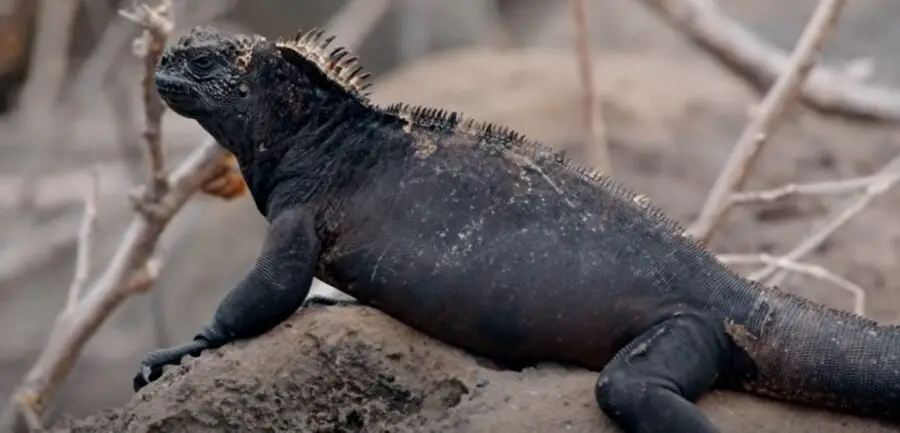I recently saw a couple of marine iguanas on holiday. My friend asked me, “Are marine iguanas dangerous?”
I tried to reassure her, but have you see what marine iguanas look like? These godzilla-like creatures impose a demeanor that can terrify you. What do marine iguanas eat?
In this article, you will find out, are marine iguanas dangerous and all about their behavior in their native habitat.
Are Marine Iguanas Dangerous?
Thankfully, no. You can enjoy the presence of marine iguanas without feeling threatened. These magnificent reptiles do not:
- Bite
- Carry poison
- Sting
- Attack humans
Overall, the scale of danger represented by marine iguanas is miniscule. They will defend themselves if attacked, but these creatures are focused on marine life where their staple food is algae.

What Are Marine Iguanas?
Marine iguanas are also known as:
- sea iguana
- saltwater iguana
- Galápagos marine iguana
- Amblyrhynchus cristatus
They are native to the Galápagos islands with 11 subspecies. They frequent the shores when they take breaks from eating algae off volcanic rocks and throughout their habitat under the water.
Here are a few marine iguana statistics:
- Length: 4-5 feet (1.2-1.5 m)
- Weight: 1-3.3 lbs (.5-1.5 kg)
- Color: black, gray
- Physical features: spikes or spines down their back
Foraging for algae takes up most of their day and marine iguanas have no need to give humans any attention who happens to visit their native islands for tourism and adventure.
Are Marine Iguanas Friendly?
Marine iguanas are not social. They are not going to come towards you to serve as a threat or friend. They tolerate the presence of other marine iguanas, but they do not congregate together.
Only on a cold night will you see them huddling closer together. Marine iguanas are not dangerous because they are adapted to eat algae and leave humans or other animals alone.
Marine iguanas:
- Are strong swimmers
- Look for algae on volcanic rocks
- Use claws to cling onto slippery rocks
- Push out salt through their noses
- Are ectothermic who cannot regulate their body temperature
- Can slow down their heat rate by 50% to save energy

How Fast Can A Marine Iguana Move?
Although there are no land speed records being broken by marine iguanas, they can evade predators and stay away from humans quite quickly. Overall, a marine iguana is a reptile that moves slowly on land.
They have to maneuver around sharp volcanic rocks and reefs that can be slippery. Moving fast is not necessary because of the lack of predators in their native islands of the Galapagos.
A marine iguana is much faster in the water and almost elegant in the way they swim gracefully as they munch on algae.
How Do Marine Iguanas Communicate?
Marine iguanas do not make noises to communicate with each other. This is not a vocal creature and they do not seek to be social with their counterparts. Communication with their senses can be possible by using their tongues and eyes.
The predators of juvenile marine iguanas are birds of prey, snakes or rodents, but they actually get assistance from mockingbirds overhead that send warning calls to help them evade threats.
The Galapagos mockingbird to marine iguana call is a recorded form of communication that is fascinating and profound in their habitat.

Are Marine Iguanas Endangered?
No. Marine iguanas are legally protected and classified as vulnerable and close to extinction. They reside in a very small sliver on land and surrounding waters around the Galapagos islands.
Invasive species threaten their survival. Humans who seek to pouch or seize marine iguanas face prosecution.
The declaration of the vulnerable status has been given by the IUCN (International Union for Conservation of Nature). Some of the reasons are due to:
- Warmer waters
- Less algae growth
- Shrinking average body sizes
- Lowe life expectancy higher amounts of ecotourism in the Galapagos
- Habitat invasion of cats, dogs, pigs, rats
- Construction/erosion of breeding grounds
There are three areas in the Galapagos that classify the marine iguana as being endangered since their breeding grounds are being threatened. They are the islands of:
- Genovesa
- Santiago
- San Christobel
What Is The Marine Iguana’s Biggest Threat?
The biggest threat to the future of marine iguanas iguanas is threefold:
- Humans
- Invasive animals
- Climate change
1. Humans
Humans continue to flood the Galapagos with their desire to seek out adventure and ecotourism in one of the most beautiful places on Earth. It is hard to blame humans for their desire and curiosity to seek out new places to visit.
The trash, traffic, construction and nature of humans to seek interaction, limits the marine iguana to go near the area when we are present. This is not so a social animal and interaction could be harmful to them.
Iguanas can attack us as well. More on that here.
2. Invasive animals
The following animals were never on the Galapagos before humans arrived and settled there:
- Dogs
- Cats
- Pigs
- Rats
From ships to planes, these animals arrived and multiplied. A juvenile marine iguana is an easy target for a hungry animal that feeds off meat.
Both species involved may bite and cause harm. More on iguana bites can be found here.
Unlike the marine iguanas who devour algae alone, the invasive animals that we are very familiar with are threatening the survival of marine iguanas.
3. Climate Change
Since marine iguanas are ectothermic, they cannot regulate their own body temperature.
The warming of water in their native habitat is posing a threat to their body temperature, breeding habits, ability to thrive off algae and more. Climate change is threatening plenty of marine life as well.
Does a Marine Iguana Stop Its Heart?
Marine iguanas are most famously known for their picture with salt crystals around their noses. They sneeze or excrete salt when they exit the water.
When they are underwater, they try to go undetected by sharks and other predators. A shark can sense the heartbeat of a marine iguana. These reptiles can actually stop beating their hearts for a maximum of 45 minutes when they are under the threat of nearby sharks.
Final Thoughts
These are some of their coolest facts and details that I’m happy to share with you today.
Marine iguana are interesting, fascinating, non-threatening, but vulnerable in today’s world as their overall numbers continue to shrink.
Thank you for visiting PocketPetCentral.com for the best information to help you enjoy the life of your pocket pet companion in a fun, safe & healthy way.


